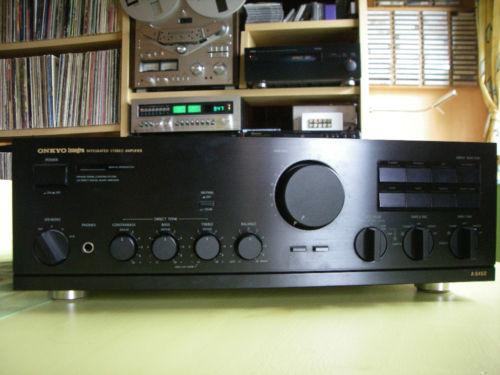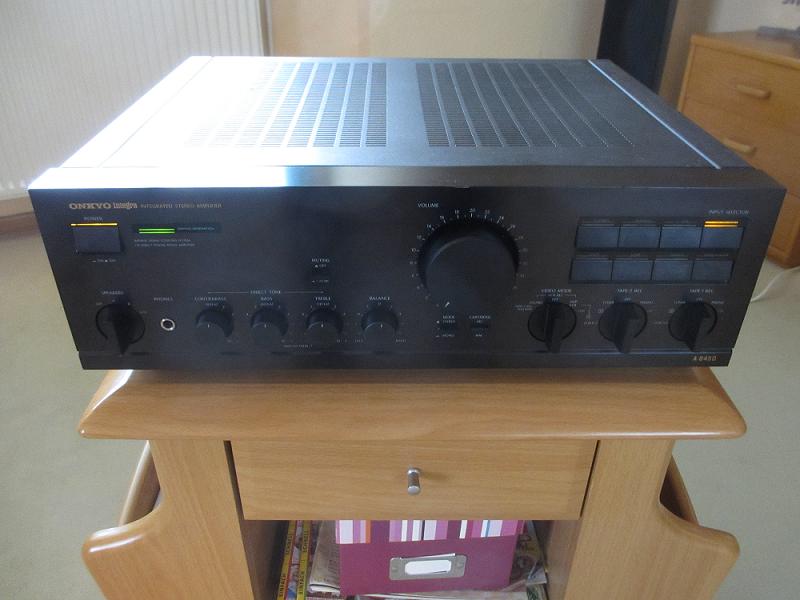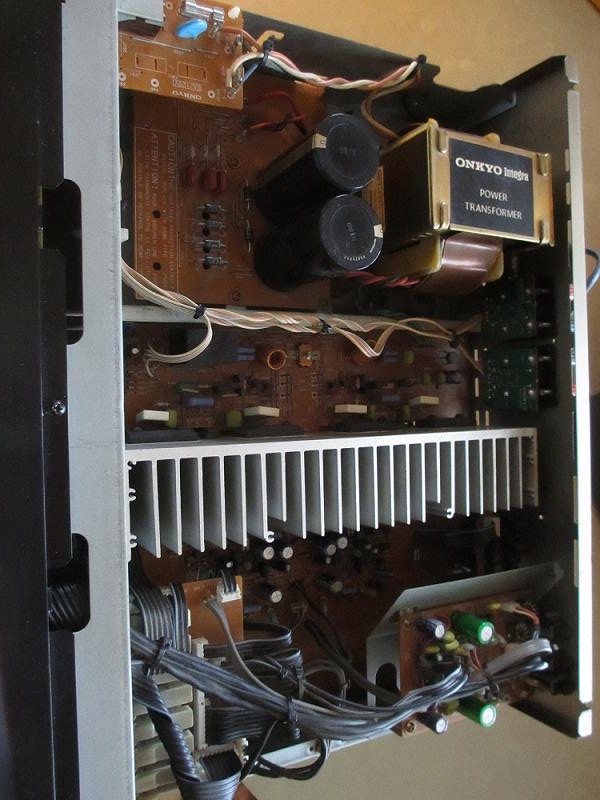Difference between revisions of "Onkyo A-8450"
| (12 intermediate revisions by 10 users not shown) | |||
| Line 1: | Line 1: | ||
__NOTOC__ | __NOTOC__ | ||
| − | == | + | == Data == |
| − | {{ | + | {{navigation}} |
| − | ''' | + | '''General''' |
| − | * | + | * Manufacturer: [[Onkyo]] |
| − | * | + | * Model: A-8450 |
| − | * | + | * Years of manufacture: 1988 ?!? |
| − | * | + | * Type: Integrated amplifier |
| − | * | + | * Remote control: No |
| − | * | + | * Power consumption: 330 watts |
| − | * | + | * Dimensions: 435 × 147 × 388 mm (W×H×D) |
| − | * | + | * Weight: 11.2 kg |
| − | * | + | * Color: black / silver |
| − | * | + | * Original price approx.: 700.-DM |
| − | ''' | + | '''Connections''' |
| − | * | + | * Number of inputs: 6 (Cinch) |
| − | + | Phono (MM/MC) | |
** Tuner | ** Tuner | ||
** CD | ** CD | ||
| − | ** | + | ** 2× Aux (VCR and VDP) |
| − | ** | + | ** 2× Tape |
| − | * | + | * Number of outputs: 3 |
| − | ** | + | ** Headphones (6.3 mm jack) |
| − | ** | + | ** 2× Tape Rec. |
| − | ** | + | ** 2× loudspeaker |
| − | ''' | + | '''Technical Data''' |
| − | * | + | * Sine power: |
| − | ** | + | ** 2× 155 watts into 4 ohms, 2× 103 watts into 8 ohms. |
| − | + | 80 watts min. (rms) into 8 ohms, both channels driven, 20 Hz to 20,000 Hz, with a total harmonic distortion of no more than 0.008%. | |
| − | * | + | * Output power: |
| − | ** | + | ** 2× 120 watts into 4 ohms /1kHz DIN. |
| − | + | 2× 90 watts into 8 ohms /1kHz DIN | |
| − | * | + | * Total harmonic distortion: 0.008% at rated power at 1Watt |
| − | * | + | * Attenuation factor: 50 (at 8 Ohm) |
| − | * | + | * Input (Sensitivity/Impedance) |
| − | ** Phono (MM): 2 | + | ** Phono (MM): 2.5 mV / 50 kOhm |
| − | ** Phono (MC): | + | ** Phono (MC): 160 µV / 220 Ohm |
| − | ** Tuner, CD, CD | + | ** Tuner, CD, CD direct, Aux, Tape: 150 mV / 50 kOhm |
| − | ** Tape Rec.: | + | ** Tape Rec.: 150 mV / 1,5 kOhm |
| − | * | + | * Output (level/impedance): |
| − | * | + | * Frequency response: 2 - 50,000 Hz (+0, -1dB). |
| − | * | + | * Tone control: |
| − | ** Contrabass: | + | ** Contrabass: +/-10 dB (at 20 Hz). |
| − | + | Bass: +/-10 dB (at 70 Hz) | |
| − | + | Treble: +/-8 dB (at 20 kHz) | |
| − | * Loudness: | + | * Loudness: No |
| − | * Subsonic: | + | * Subsonic: no |
| − | * Mute: | + | * Mute: yes (-20 dB) |
| − | * Direct/Line-Straight: | + | * Direct/Line-Straight: yes |
| − | ''' | + | '''Special Features''' |
| − | * | + | * Switch-on delay via relay |
| + | * Switching off the power amplifier in case of speaker overload | ||
| + | * Illumination of the positions for the direct selector switches in the same way as known from the | ||
| + | * "big brother" A8470, this model unfortunately does not have. | ||
| + | == Remarks == | ||
| + | Other models of the same series: | ||
| + | * [[Onkyo A-8420|A-8420]] | ||
| + | * [[Onkyo A-8430|A-8430]] | ||
| + | * [[Onkyo A-8450|A-8450]] | ||
| + | * [[Onkyo A-8470|A-8470]] | ||
| − | == | + | == Pictures == |
| − | + | [[File:Onkyo Integra A 8450.jpg]] | |
| + | [[File:Onkyo Integra A 8450 back.jpg]] | ||
| + | [[File:Onkyo_a8450_on.jpeg]] | ||
| + | [[File:Onkyo_a_8450_-_innen.jpeg]] | ||
| − | == | + | == Reports == |
| + | The power amp's automatic shutdown feature works reliably. I connected relatively weak 30W speakers as a test. As soon as an overload threatened, the relay reacted and nothing broke. | ||
| + | By the way, you can save teenagers (for their own protection) from tinitus this way: Too loud? -> Clack! Wait a few seconds. Still too loud? -> clack! The teenager can quickly lose the fun of his dad's old stereo ;-) | ||
| − | == | + | Remark: How should an amplifier know how weak or strong a connected speaker is? Please explain! The only thing that could be: if too much current is drawn, i.e. the impedance is too low, a protection circuit might kick in. Otherwise 30W speakers would simply "burn out". Furthermore: the power amp power specifications mentioned above can't be correct: Maximum power consumption (according to the nameplate) 330 watts, but 2x 220 watts are supposed to arrive at the speakers at 2ohms? |
| + | It is doubtful whether the amplifier is at all 2 Ohm stable with only two power transistors. | ||
| + | |||
| + | With daily use and frequent switching of the rotary selector switches (for the audio sources and speaker pairs), these rotary switches wore out and had to be replaced after about 10 years. | ||
| + | However, if you don't want this trouble/cost, you have the option to use the unit as a pure power amplifier (e.g. behind a mixing console) by bypassing all connections and tone controls and making only the "main input" directly usable. | ||
| + | |||
| + | Note: With the rotary selector switches, the grub screws on the control knobs usually come loose. Even here Onkyo has thought along: Nothing needs to be unscrewed or opened and certainly no technician needs to be commissioned with the change of the switches (financial K.O. criterion). Just take a 2mm Allen screwdriver and retighten the grub screws, which are accessible via small holes on the underside of the front panel (after 30 years). Sometimes the world is quite simple ;-). | ||
| + | The amplifier also doesn't need to be made usable(or even rebuilt) for the use of the "main input"; the factory CD-Direct switch bypasses the whole Klagregel network, only the volume control remains active! | ||
| + | Otherwise, a little contact spray (V61) for the switches and tone controls/balance will help for the next few years. | ||
| + | |||
| + | Also this amplifier is an all around class device(a real) analog amplifier without any A/D converters and servo drives (remote control). | ||
| + | |||
| + | == Sources == | ||
| + | * [[Onkyo A-8470|A-8450]] | ||
| + | * Original Onkyo manual | ||
== Links == | == Links == | ||
| − | [[ | + | [[Category:Integrated amplifier]] |
Latest revision as of 12:46, 1 December 2019
Data[edit]
General
- Manufacturer: Onkyo
- Model: A-8450
- Years of manufacture: 1988 ?!?
- Type: Integrated amplifier
- Remote control: No
- Power consumption: 330 watts
- Dimensions: 435 × 147 × 388 mm (W×H×D)
- Weight: 11.2 kg
- Color: black / silver
- Original price approx.: 700.-DM
Connections
- Number of inputs: 6 (Cinch)
Phono (MM/MC)
- Tuner
- CD
- 2× Aux (VCR and VDP)
- 2× Tape
- Number of outputs: 3
- Headphones (6.3 mm jack)
- 2× Tape Rec.
- 2× loudspeaker
Technical Data
- Sine power:
- 2× 155 watts into 4 ohms, 2× 103 watts into 8 ohms.
80 watts min. (rms) into 8 ohms, both channels driven, 20 Hz to 20,000 Hz, with a total harmonic distortion of no more than 0.008%.
- Output power:
- 2× 120 watts into 4 ohms /1kHz DIN.
2× 90 watts into 8 ohms /1kHz DIN
- Total harmonic distortion: 0.008% at rated power at 1Watt
- Attenuation factor: 50 (at 8 Ohm)
- Input (Sensitivity/Impedance)
- Phono (MM): 2.5 mV / 50 kOhm
- Phono (MC): 160 µV / 220 Ohm
- Tuner, CD, CD direct, Aux, Tape: 150 mV / 50 kOhm
- Tape Rec.: 150 mV / 1,5 kOhm
- Output (level/impedance):
- Frequency response: 2 - 50,000 Hz (+0, -1dB).
- Tone control:
- Contrabass: +/-10 dB (at 20 Hz).
Bass: +/-10 dB (at 70 Hz) Treble: +/-8 dB (at 20 kHz)
- Loudness: No
- Subsonic: no
- Mute: yes (-20 dB)
- Direct/Line-Straight: yes
Special Features
- Switch-on delay via relay
- Switching off the power amplifier in case of speaker overload
- Illumination of the positions for the direct selector switches in the same way as known from the
- "big brother" A8470, this model unfortunately does not have.
Remarks[edit]
Other models of the same series:
Pictures[edit]
Reports[edit]
The power amp's automatic shutdown feature works reliably. I connected relatively weak 30W speakers as a test. As soon as an overload threatened, the relay reacted and nothing broke. By the way, you can save teenagers (for their own protection) from tinitus this way: Too loud? -> Clack! Wait a few seconds. Still too loud? -> clack! The teenager can quickly lose the fun of his dad's old stereo ;-)
Remark: How should an amplifier know how weak or strong a connected speaker is? Please explain! The only thing that could be: if too much current is drawn, i.e. the impedance is too low, a protection circuit might kick in. Otherwise 30W speakers would simply "burn out". Furthermore: the power amp power specifications mentioned above can't be correct: Maximum power consumption (according to the nameplate) 330 watts, but 2x 220 watts are supposed to arrive at the speakers at 2ohms? It is doubtful whether the amplifier is at all 2 Ohm stable with only two power transistors.
With daily use and frequent switching of the rotary selector switches (for the audio sources and speaker pairs), these rotary switches wore out and had to be replaced after about 10 years. However, if you don't want this trouble/cost, you have the option to use the unit as a pure power amplifier (e.g. behind a mixing console) by bypassing all connections and tone controls and making only the "main input" directly usable.
Note: With the rotary selector switches, the grub screws on the control knobs usually come loose. Even here Onkyo has thought along: Nothing needs to be unscrewed or opened and certainly no technician needs to be commissioned with the change of the switches (financial K.O. criterion). Just take a 2mm Allen screwdriver and retighten the grub screws, which are accessible via small holes on the underside of the front panel (after 30 years). Sometimes the world is quite simple ;-). The amplifier also doesn't need to be made usable(or even rebuilt) for the use of the "main input"; the factory CD-Direct switch bypasses the whole Klagregel network, only the volume control remains active! Otherwise, a little contact spray (V61) for the switches and tone controls/balance will help for the next few years.
Also this amplifier is an all around class device(a real) analog amplifier without any A/D converters and servo drives (remote control).
Sources[edit]
- A-8450
- Original Onkyo manual



